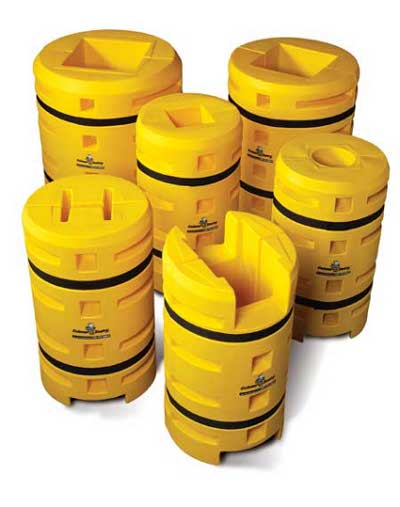by Danille Bettridge, Web Store Specialist
Column protectors are guards that fit on posts, beams, pipes, columns, or any vertical surface. Column protectors serve as a buffer between the surface and possible collisions, absorbing the impact. What are benefits of column protectors? 
- Helps prevent damage to the racking and/or column it is protecting
- Significantly reduces the chance of damage from a collision to the forklift, vehicle, or person
- Decreases repair expenses sustained by racking and forklifts during a collision
- Bright color options Increase their visibility to forklift operators and act as guides warning people approaching to keep a safe distance.
- Minimizes obstruction that might occur from a collision
- Ranges in pricing to fit any budget
- Easy Installation options are available
- Little to no maintenance is required once installed
-
Size
- Width: Choose a width that matches the amount of available space, the desired type of column protector material you would like, and the width of the vertical space you want to protect.
- Height: Column protectors are available in customizable sizes, but standard sizes run from 12 inches to 12 feet, and some may be stacked one atop the other to provide additional height coverage.
- Shape: Some column protectors come in molded shapes with cut outs in the center to fit tightly against I-shaped, square, and round verticals. Most are cylindrical to create an equal barrier around the column, but some are cube- or hexagon-shaped.
- Pieces: Most column protectors are usually two-piece units that are fastened around the vertical. However, a few column protectors are single-piece, pliable units that wrap around the vertical.
-
Color
- Yellow (most common color)
- Lime green
- Orange
- Multi-colored (usually striped with black and a bright color)
- Reflective (usually added to a solid color)
-
Material
- Polyethylene protectors: Polyethylene protectors are made to have a cushion of air between the column and its outside wall to absorb any impact. This type of material is the most commonly used kind of column protector in material handling industries. Polyethylene protectors tend to be thicker than other kinds of protectors.
- Steel protectors: Steel protectors employ heavy-duty strength and a bolt system to withstand a collision. While they are heavier than some other kinds of column protector materials, they tend to be thinner in overall diameter, taking up less space around the column.
- Vinyl protectors: Vinyl protectors are also known as "bumper wraps." Vinyl protection material runs about ½ inch thick and comes in a roll that allows you to cut to a custom size. This kind of protection material is commonly used at car dealerships and shopping centers to protect light poles from minor collisions.
- Foam Protectors: Foam protectors, also known as "padded column wraps," have a padded center with a nylon cover to help reduce collision damage. Foam protectors are commonly used in parking garages for minor impacts, such as those caused by car doors.
-
Fastening
- Velcro straps: Velcro straps are generally made of nylon, and wrap around the column protector to secure it to the surface. Velcro straps are easy to install and maintain. They are available in multiple colors including reflective finish.
- Bolts: Bolts fasten pieces of the column protector together, and can also fasten it to the ground.
- Snap fasteners: Snap fasteners use a four-rivet connection attached to the column protector that locks into an upright column.
- Cable ties: Cable ties wrap around the column protector to fasten it in place.
- Reflective tape: Reflective tape wraps around lighter duty column protectors in place. They come in a variety of colors.
- Each column protector can range in price from $15 to more than $1,000, depending on the type, as described earlier in this article.
- Column protectors that use non-standard options are more expensive since they require special customization.
